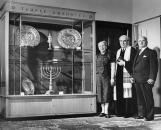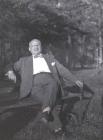1
The Birth of the Aron Museum, 19532
The Aron Museum with founders Josef and Anna Aron and Rabbi Harry J. Stern1953
Temple Emanu-El, Montreal, Quebec

3
This photograph documents the inauguration in 1953 of Temple Emanu-El's Museum of Jewish Ceremonial Art Objects. The museum, later to be renamed the Aron Museum, was founded with five works from Josef and Anna Aron's private collection. Today, the Aron Museum houses around 300 pieces of Judaica.4
Josef Aron was the younger brother of Paul Aron. Like his brother, Josef was born in Frankfurt am Main in the late nineteenth century and was raised as an Orthodox Jew. Yet unlike his older brother, Josef decided that the Orthodox lifestyle was not for him. Together with his brother Herman, Josef decided to leave Germany and see the world. They travelled first to New York, and eventually made their way to Montreal by the early years of the twentieth century.6
Josef made his fortune in the Klondike in gold, and later opened a business in Montreal. His financial success allowed him and his wife Anna to travel and collect antique Jewish art objects. Their grandniece, Evelyn Uditsky, doubts that Josef and Anna ever used the pieces themselves. She believes that her Uncle Joe had a desire to collect Judaica because he understood it, and because he knew about Jewish ceremonial objects from his childhood. Josef was also familiar with his brother Paul's collection of Judaica, and was likely inspired by his brother's efforts to preserve his collection. Josef visited his brother's home in Jerusalem on more than one occasion and probably acquired some pieces from Paul's Frankfurt collection.7
Temple Emanu-El was an integral part of Josef and Anna Aron's lives. Many of their friendships originated from their involvement with the Temple. In particular, they became very close friends with the Temple's rabbi, Rabbi Harry Joshua Stern. It was Rabbi Stern who first suggested the idea of founding the museum.It all began one evening when Rabbi Stern was invited to Josef and Anna Aron's home for dinner. Josef proudly showed the Rabbi his collection of Jewish ritual art.
9
The centrepiece of the collection was a large turn-of-the-century silver Chanukah candelabrum. The nine-branched candelabrum is traditionally lit during the holiday of Chanukah to commemorate the re-dedication of the Temple of Jerusalem in 165 B.C.E. and to celebrate the miracle of lights that followed.10
The menorah originally came from the Rothschild residence in Frankfurt am Main, Josef's hometown. The Rothschild family founded a banking house in Frankfurt which later expanded in branches across Western Europe. The family is well-known for its wealth and philanthropic largesse, as well as for its observance of Jewish rituals and tradition. Somehow, the candelabrum had found its way into the home of Ignatz Aron, one of Josef's brothers. Ignatz passed away in the early years of the 1930s in Frankfurt, leaving the candelabrum to Josef.11
Rabbi Stern was inspired by the story of the candelabrum, and asked Josef and Anna if he could borrow it for the ritual candle-lighting that would take place at Temple Emanu-El during the holiday of Chanukah. Of course, the Arons agreed.The whole congregation was impressed by the menorah during the candle-lighting ceremony. This sparked another idea. Upon returning the menorah, Rabbi Stern suggested that the Arons donate their collection to the Temple and thereby start a museum of Jewish ceremonial art objects. It would be the first of its kind in Canada.
12
On May 22, 1953, the Museum of Jewish Ceremonial Art Objects was inaugurated. In his opening speech, Josef Aron emphasized the museum's purpose, to educate both the members of the Temple's congregation and the wider non-Jewish public. Both Rabbi Stern and the Arons believed that education about the Jewish faith through its art objects would correct misconceptions about Judaism and help in putting an end to anti-Semitism.The museum began with just one display case, filled with five pieces from Josef and Anna Aron's private collection - including the Rothschild candelabrum.


